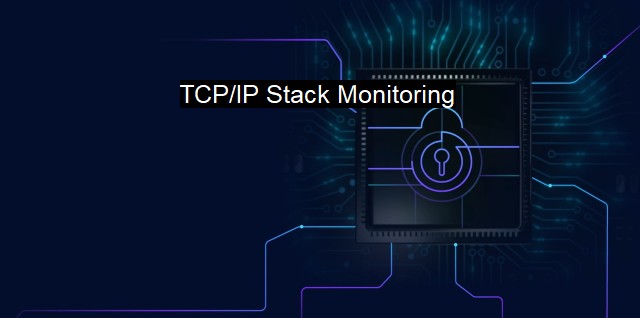What is TCP/IP Stack Monitoring?
Ensuring Network Security: TCP/IP Stack Monitoring For Threat Detection and Attack Prevention
TCP/IP Stack Monitoring is a crucial element within the context of cybersecurity and antivirus protection. It involves observing and analyzing the Transport Control Protocol/Internet Protocol (TCP/IP) stack's health and performance. Beyond merely sustaining internet connectivity, this critical piece of architecture serves as an infrastructure for many cybersecurity functions. The monitoring of this stack helps as part of a broader defensive strategy against possible threats and attacks that might exploit vulnerabilities within this core communication framework.To better understand, it's important to grasp the concept of the TCP/IP stack. This is a set of communication protocols used to interconnect network devices on the internet. It splits data communication into four different layers, namely: the network interface, internet, transport, and application. Each of these layers performs distinct functions and relies on the other for the most efficient data transmission.
Network interface is the lowest layer that manages the physical networking hardware - server, routers, switches and so on. The internet layer is responsible for IP addressing and routing data packets on the network. The transport layer oversees data flow between systems and serves reliable data transport, while the uppermost application layer provides data to applications and services.
Examining and controlling the TCP/IP stack does two critical things within the context of cybersecurity. First, it reveals potential trouble spots that malefactors could exploit given the opportunity. Second, it ensures the healthy, proper, efficient and secure data exchange within the network. Therefore, administrators use TCP/IP Stack Monitoring to identify irregularities or inefficiencies that they can remedy, mitigating cyber risks while improving the network's efficacy.
This monitoring can detect inconsistencies caused by malicious attacks such as IP Spoofing, DDoS attacks, and TCP/IP Hijacking. Early identification of such cases would mean faster responses in activating appropriate countermeasures against them. IP Spoofing involves tricking protocols into accepting rogue source IP Addresses. By monitoring TCP/IP stack activities, they can detect such suspicious activities and aid in preventing or minimizing damage.
TCP/IP Stack Monitoring, in relation to antivirus solutions, is also central to zero-day threats detection – threats exploiting unknown weaknesses in the system. Real-time monitoring helps to automatically quarantine suspicious activities, ensuring uninterrupted service particularly in high-stakes environments, but also greatly reduces the workload of cybersecurity professionals, allowing a streamlined and more effective protective stance.
From a maintenance perspective, high-resolution insights obtained from TCP/IP Stack Monitoring enable IT departments to maintain peak service delivery. Issues related to bandwidth usage, outage, or latency can be identified and resolved swiftly with minimum impact on the user end. Noting these bottlenecks in real-time allows for higher operational efficiency, increased system reliability, and an overall more secured network environment.
TCP/IP Stack Monitoring is quintessential for maintaining and driving regulatory compliance standards, particularly for businesses operating within jurisdictions with harsh data and privacy regulations. Pieces of legislation such as GDPR or CCPA require cyber hygiene – reactive and proactive – to protect customer data. Proper monitoring of TCP/IP stack is fundamental within this operation standpoint.
The TCP/IP stack's pivotal role in the digital world, driven more so by the rapidly growing IoT universe, highlights the importance of TCP/IP Stack Monitoring. Cybersecurity protocols are roundly touted to be as strong as their weakest link. Monitoring the TCP/IP forms an important layer of defense. Its dynamic capability for action, whether functioning as a diagnostic tool, a health regulator, a cybercrime watch-port, makes TCP/IP Stack Monitoring an invisible shield, thereby providing, albeit beneath the surface, a critical part to a secure Internet.

TCP/IP Stack Monitoring FAQs
What is TCP/IP stack monitoring?
TCP/IP stack monitoring is the process of examining and analyzing the data packets that are travelling through the TCP/IP stack of a networked device. This monitoring is usually done to ensure the proper functioning and security of a network, and to detect any potential cyber threats.Why is TCP/IP stack monitoring important for cybersecurity?
TCP/IP stack monitoring is important for cybersecurity because the TCP/IP stack is the foundation of all internet communication. By monitoring the stack, cybersecurity professionals can detect and prevent attacks such as denial-of-service attacks, malware infections, and other types of cyber threats.What tools are used for TCP/IP stack monitoring?
There are several tools that are used for TCP/IP stack monitoring, including network sniffers, intrusion detection systems (IDS), intrusion prevention systems (IPS), and firewalls. These tools can help monitor and analyze network traffic, detect potential security threats, and block or mitigate attacks.Can antivirus software perform TCP/IP stack monitoring?
Antivirus software can perform some level of TCP/IP stack monitoring, but it is not typically designed for this purpose. Antivirus software primarily focuses on detecting and removing malware infections, rather than monitoring network traffic for potential security threats. However, some antivirus programs may have additional features that allow for more advanced network monitoring and security.| | A | | | B | | | C | | | D | | | E | | | F | | | G | | | H | | | I | | | J | | | K | | | L | | | M | |
| | N | | | O | | | P | | | Q | | | R | | | S | | | T | | | U | | | V | | | W | | | X | | | Y | | | Z | |
| | 1 | | | 2 | | | 3 | | | 4 | | | 7 | | | 8 | | |||||||